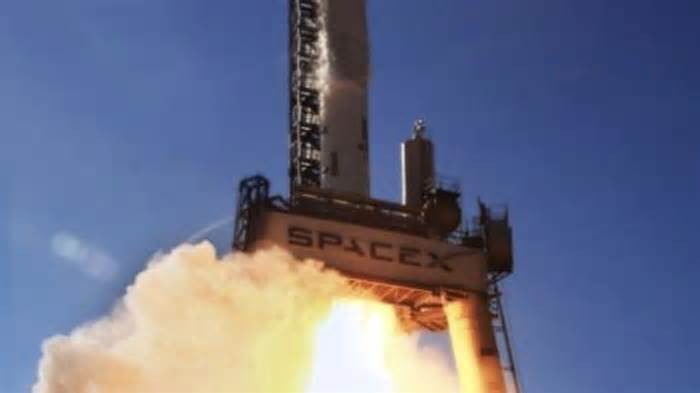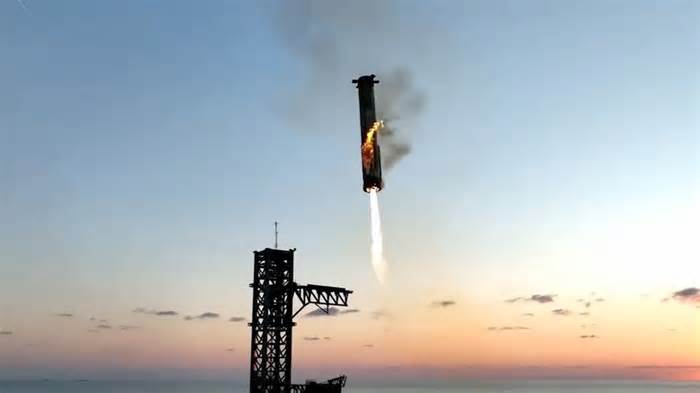
Rocket Report: Australia says yes to the launch; Russia delivers for Iran
- by Ars Technica
- Nov 08, 2024
- 0 Comments
- 0 Likes Flag 0 Of 5

Sign Me
Up!
Virgin Galactic is on the hunt for cash. Virgin Galactic is proposing to raise $300 million in additional capital to accelerate production of suborbital spaceplanes and a mothership aircraft the company says can fuel its long-term growth, Space News reports. The company, founded by billionaire Richard Branson, suspended operations of its VSS Unity suborbital spaceplane earlier this year. VSS Unity hit a monthly flight cadence carrying small groups of space tourists and researchers to the edge of space, but it just wasn't profitable. Now, Virgin Galactic is developing larger Delta-class spaceplanes it says will be easier and cheaper to turn around between flights.
All-in with Delta ... Michael Colglazier, Virgin Galactic's CEO, announced the company's appetite for fundraising in a quarterly earnings call with investment analysts Wednesday. He said manufacturing of components for Virgin Galactic's first two Delta-class ships, which the company says it can fund with existing cash, is proceeding on schedule at a factory in Arizona. Virgin Galactic previously said it would use revenue from paying passengers on its first two Delta-class ships to pay for development of future vehicles. Instead, Virgin Galactic now says it wants to raise money to speed up work on the third and fourth Delta-class vehicles, along with a second airplane mothership to carry the spaceplanes aloft before they release and fire into space. (submitted by Ken the Bin and EllPeaTea)
ESA breaks its silence on Themis. The European Space Agency has provided a rare update on the progress of its Themis reusable booster demonstrator project, European Spaceflight reports. ESA is developing the Themis test vehicle for atmospheric flights to fine-tune technologies for a future European reusable rocket capable of vertical takeoffs and vertical landings. Themis started out as a project led by CNES, the French space agency, in 2018. ESA member states signed up to help fund the project in 2019, and the agency awarded ArianeGroup a contract to move forward with Themis in 2020. At the time, the first low-altitude hop test was expected to take place in 2022.
Some slow progress ... Now, the first low-altitude hop is scheduled for 2025 from Esrange Space Centre in Sweden, a three-year delay. This week, ESA said engineers have completed testing of the Themis vehicle's main systems, and assembly of the demonstrator is underway in France. A single methane-fueled Prometheus engine, also developed by ArianeGroup, has been installed on the rocket. Teams are currently adding avionics, computers, electrical systems, and cable harnesses. Themis' stainless steel propellant tanks have been manufactured, tested, and cleaned and are now ready to be installed on the Themis demonstrator. Then, the rocket will travel by road from France to the test site in Sweden for its initial low-altitude hops. After those flights are complete, officials plan to add two more Prometheus engines to the rocket and ship it to French Guiana for high-altitude test flights. (submitted by Ken the Bin and EllPeaTea)
SpaceX will give the ISS a boost. A Cargo Dragon spacecraft docked to the International Space Station on Tuesday morning, less than a day after lifting off from Florida. As space missions go, this one is fairly routine, ferrying about 6,000 pounds (2,700 kilograms) of cargo and science experiments to the space station. One thing that's different about this mission is that it delivered to the station a tiny 2 lb (900 g) satellite named LignoSat, the first spacecraft made of wood, for later release outside the research complex. There is one more characteristic of this flight that may prove significant for NASA and the future of the space station, Ars reports. As early as Friday, NASA and SpaceX have scheduled a "reboost and attitude control demonstration," during which the Dragon spacecraft will use some of the thrusters at the base of the capsule. This is the first time the Dragon spacecraft will be used to move the space station.
Dragon's breath ... Dragon will fire a subset of its 16 Draco thrusters, each with about 90 pounds of thrust, for approximately 12.5 minutes to make a slight adjustment to the orbital trajectory of the roughly 450-ton space station. SpaceX and NASA engineers will analyze the results from the demonstration to determine if Dragon could be used for future space station reboost opportunities. The data will also inform the design of the US Deorbit Vehicle, which SpaceX is developing to perform the maneuvers required to bring the space station back to Earth for a controlled, destructive reentry in the early 2030s. For NASA, demonstrating Dragon's ability to move the space station will be another step toward breaking free of reliance on Russia, which is currently responsible for providing propulsion to maneuver the orbiting outpost. Northrop Grumman's Cygnus supply ship also previously demonstrated a reboost capability. (submitted by Ken the Bin and N35t0r)
Russia launches Soyuz in service of Iran. Russia launched a Soyuz rocket Monday carrying two satellites designed to monitor the space weather around Earth and 53 small satellites, including two Iranian ones, Reuters reports. The primary payloads aboard the Soyuz-2.1b rocket were two Ionosfera-M satellites to probe the ionosphere, an outer layer of the atmosphere near the edge of space. Solar activity can alter conditions in the ionosphere, impacting communications and navigation. The two Iranian satellites on this mission were named Kowsar and Hodhod. They will collect high-resolution reconnaissance imagery and support communications for Iran.
A distant third ... This was only the 13th orbital launch by Russia this year, trailing far behind the United States and China. We know of two more Soyuz flights planned for later this month, but no more, barring a surprise military launch (which is possible). The projected launch rate puts Russia on pace for its quietest year of launch activity since 1961, the year Yuri Gagarin became the first person to fly in space. A major reason for this decline in launches is the decisions of Western governments and companies to move their payloads off of Russian rockets after the invasion of Ukraine. For example, OneWeb stopped launching on Soyuz in 2022, and the European Space Agency suspended its partnership with Russia to launch Soyuz rockets from French Guiana. (submitted by Ken the Bin)
H3 deploys Japanese national security satellite. Japan launched a defense satellite Monday aimed at speedier military operations and communication on an H3 rocket and successfully placed it into orbit, the Associated Press reports. The Kirameki 3 satellite will use high-speed X-band communication to support Japan's defense ministry with information and data sharing, and command and control services. The satellite will serve Japanese land, air, and naval forces from its perch in geostationary orbit alongside two other Kirameki communications satellites.
Gaining trust ... The H3 is Japan's new flagship rocket, developed by Mitsubishi Heavy Industries (MHI) and funded by the Japan Aerospace Exploration Agency (JAXA). The launch of Kirameki 3 marked the third consecutive successful launch of the H3 rocket, following a debut flight in March 2023 that failed to reach orbit. This was the first time Japan's defense ministry put one of its satellites on the H3 rocket. The first two Kirameki satellites launched on a European Ariane 5 and a Japanese H-IIA rocket, which the H3 will replace. (submitted by Ken the Bin, tsunam, and EllPeaTea)
Rocket Lab enters the race for military contracts. Rocket Lab is aiming to chip away at SpaceX’s dominance in military space launch, confirming its bid to compete for Pentagon contracts with its new medium-lift rocket, Neutron, Space News reports. Last month, the Space Force released a request for proposals from launch companies seeking to join the military's roster of launch providers in the National Security Space Launch (NSSL) program. The Space Force will accept bids for launch providers to "on-ramp" to the NSSL Phase 3 Lane 1 contract, which doles out task orders to launch companies for individual missions. In order to win a task order, a launch provider must be on the Phase 3 Lane 1 contract. Currently, SpaceX, United Launch Alliance, and Blue Origin are the only rocket companies eligible. SpaceX won all of the first round of Lane 1 task orders last month.
Joining the club ... The Space Force is accepting additional risk for Lane 1 missions, which largely comprise repeat launches deploying a constellation of missile-tracking and data-relay satellites for the Space Development Agency. A separate class of heavy-lift missions, known as Lane 2, will require rockets to undergo a thorough certification by the Space Force to ensure their reliability. In order for a launch company to join the Lane 1 roster, the Space Force requires bidders to be ready for a first launch by December 2025. Peter Beck, Rocket Lab's founder and CEO, said he thinks the Neutron rocket will be ready for its first launch by then. Other new medium-lift rockets, such as Firefly Aerospace's MLV and Relativity's Terran-R, almost certainly won't be ready to launch by the end of next year, leaving Rocket Lab as the only company that will potentially join incumbents SpaceX, ULA, and Blue Origin. (submitted by Ken the Bin)
Next Starship flight is just around the corner. Less than a month has passed since the historic fifth flight of SpaceX's Starship, during which the company caught the booster with mechanical arms back at the launch pad in Texas. Now, another test flight could come as soon as November 18, Ars reports. The improbable but successful recovery of the Starship first stage with "chopsticks" last month, and the on-target splashdown of the Starship upper stage halfway around the world, allowed SpaceX to avoid an anomaly investigation by the Federal Aviation Administration. Thus, the company was able to press ahead on a sixth test flight if it flew a similar profile. And that's what SpaceX plans to do, albeit with some notable additions to the flight plan.
Around the edges … Perhaps the most significant change to the profile for Flight 6 will be an attempt to reignite a Raptor engine on Starship while it is in space. SpaceX tried to do this on a test flight in March but aborted the burn because the ship's rolling motion exceeded limits. A successful demonstration of a Raptor engine relight could pave the way for SpaceX to launch Starship into a higher stable orbit around Earth on future test flights. This is required for SpaceX to begin using Starship to launch Starlink Internet satellites and perform in-orbit refueling experiments with two ships docked together. (submitted by EllPeaTea)
China's version of Starship. China has updated the design of its next-generation heavy-lift rocket, the Long March 9, and it looks almost exactly like a clone of SpaceX's Starship rocket, Ars reports. The Long March 9 started out as a conventional-looking expendable rocket, then morphed into a launcher with a reusable first stage. Now, the rocket will have a reusable booster and upper stage. The booster will have 30 methane-fueled engines, similar to the number of engines on SpaceX's Super Heavy booster. The upper stage looks remarkably like Starship, with flaps in similar locations. China intends to fly this vehicle for the first time in 2033, nearly a decade from now.
A vehicle for the Moon … The reusable Long March 9 is intended to unlock robust lunar operations for China, similar to the way Starship, and to some extent Blue Origin's Blue Moon lander, promises to support sustained astronaut stays on the Moon's surface. China says it plans to land its astronauts on the Moon by 2030, initially using a more conventional architecture with an expendable rocket named the Long March 10, and a lander reminiscent of NASA's Apollo lunar lander. These will allow Chinese astronauts to remain on the Moon for a matter of days. With Long March 9, China could deliver massive loads of cargo and life support resources to sustain astronauts for much longer stays.
Ta-ta to the tripod. The large three-legged vertical test stand at SpaceX's engine test site in McGregor, Texas, is being decommissioned, NASA Spaceflight reports. Cranes have started removing propellant tanks from the test stand, nicknamed the tripod, towering above the Central Texas prairie. McGregor is home to SpaceX's propulsion test team and has 16 test cells to support firings of Merlin, Raptor, and Draco engines multiple times per day for the Falcon 9 rocket, Starship, and Dragon spacecraft.
Some history … The tripod might have been one of SpaceX's most important assets in the company's early years. It was built by Beal Aerospace for liquid-fueled rocket engine tests in the late 1990s. Beal Aerospace folded, and SpaceX took over the site in 2003. After some modifications, SpaceX installed the first qualification version of its Falcon 9 rocket on the tripod for a series of nine-engine test-firings leading up to the rocket's inaugural flight in 2010. SpaceX test-fired numerous new Falcon 9 boosters on the tripod before shipping them to launch sites in Florida or California. Most recently, the tripod was used for testing of Raptor engines destined to fly on Starship and the Super Heavy booster.
Next three launches
Please first to comment
Related Post
Stay Connected
Tweets by elonmuskTo get the latest tweets please make sure you are logged in on X on this browser.
Sponsored
Popular Post
Tesla: Buy This Dip, Energy Growth And Margin Recovery Are Vastly Underappreciated
28 ViewsJul 29 ,2024






 Energy
Energy



















